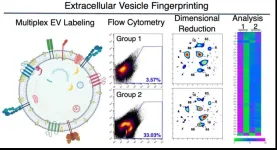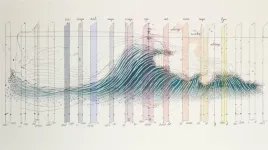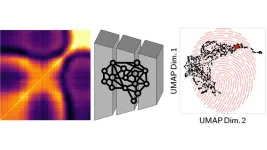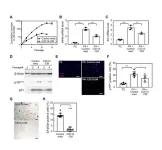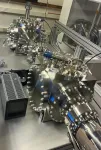(Press-News.org) Biopsies are clinical tools commonly used to diagnose a variety of diseases or to monitor tissue for abnormal growth or even rejection of a transplant. During biopsies, tissue samples are removed from the body so they can be examined more closely, but depending on the type of tissue that’s needed, the procedure can be rather invasive.
Researchers from the School of Medicine Basic Sciences recently developed an analytical tool that could lead to the use of “liquid biopsies” as a substitute for traditional biopsies for certain patients or diseases. The tool, called EV Fingerprinting, was the culmination of the dissertation work of Ariana von Lersner, a former graduate student and current postdoctoral scholar in the laboratory of Alissa Weaver, Cornelius Vanderbilt Professor of Cell and Developmental Biology.
The ”EV” in EV Fingerprinting stands for extracellular vesicles, which are membrane-bound particles that contain biologically active cargo and that contribute to cell-cell communication in health and disease. Although EVs have been observed since at least the 1980s, their origin and purpose have not been clearly defined. The last two decades have seen research into EVs skyrocket, and EVs have now been found to have roles in endocrine processes, immune responses, and even cancer progression in a variety of species, including humans.
The term “EV” encompasses vesicles of various sizes and cargos, each likely tailored to different functions. Changes in the heterogeneity of EVs in an organism can reflect changes in biological state—for example, a cancer state vs. a normal, nondisease state—which can serve as a clinically informative biomarker.
“Fingerprinting allows you to characterize EVs with minimal sample preparation in a high-throughput manner, and allows you to better classify the types of vesicles in the sample,” von Lersner said.
The technique involves isolating EVs from the rest of the cellular content in a sample, labeling them with a fluorescent lipophilic dye that intercalates into the EVs’ lipid bilayer, and running them through a flow cytometer, an instrument that shoots a laser at a sample and collects information about how the light is refracted or emitted. The collected information is compiled into a “fingerprint” that can be used to perform quantitative analyses of distinct EV populations and determine how they are altered by experimental manipulation, molecular perturbation, or disease state.
EV Fingerprinting constitutes an unprecedented advancement toward the characterization of EVs because it can analyze the composition of the lipid bilayers of the EVs in a sample and breaks the sample down into individual EV populations, which previous bulk analysis methods could not do. Using the composition of the lipid bilayers to separate EV populations is a novel approach that capitalizes on an EV characteristic that had been previously overlooked by the field.
The work was completed thanks to the contributions of Vanderbilt collaborators from the departments of cell and developmental biology, chemical and biomolecular engineering, and pathology, microbiology and immunology and the Center for EV Research, and external collaborators from the Cedars-Sinai Medical Center and Genentech. The Center for EV Research, established in 2021, is managed under Weaver’s direction and provides shared instrumentation and training for EV work, fosters interdepartmental discussion and collaboration through monthly seminars and annual retreats, and provides members with funds to conduct or share EV-related work at conferences.
“EV Fingerprinting is furthering the development of liquid biopsies in which the EVs can be used as biomarkers for diseases such as cancers or neurological disorders,” von Lersner said.
If you find yourself needing a biopsy one day and can forgo the traditional kind in favor of a simple blood draw, you may have these researchers to thank.
Go deeper
The paper “Multiparametric Single-Vesicle Flow Cytometry Resolves Extracellular Vesicle Heterogeneity and Reveals Selective Regulation of Biogenesis and Cargo Distribution” was published in ACS Nano in April 2024.
Funding
This research was funded by the National Institutes of Health and the National Science Foundation.
END
Vanderbilt scientists develop new tool that could lead to noninvasive “liquid biopsies”
Researchers from the School of Medicine Basic Sciences recently developed an analytical tool called EV Fingerprinting that could lead to the use of “liquid biopsies” as a substitute for traditional biopsies for certain patients or diseases
2024-07-16
ELSE PRESS RELEASES FROM THIS DATE:
Many breast cancer survivors do not receive genetic testing, despite being eligible
2024-07-16
ANN ARBOR, Michigan — As cancer treatment and survivorship care relies more on understanding the genetic make-up of an individual’s tumor, a new study from the University of Michigan Health Rogel Cancer Center finds that many breast cancer survivors who meet criteria for genetic counseling and testing are not receiving it.
The good news: Among those who do get testing, nearly two-thirds who have a genetic variant are reaching out to family members to talk about their results.
“Our findings support a rapidly growing movement to simplify clinical guidelines to ...
Scientists find that small regions of the brain can take micro-naps while the rest of the brain is awake and vice versa
2024-07-16
Sleep and wake: they’re totally distinct states of being that define the boundaries of our daily lives. For years, scientists have measured the difference between these instinctual brain processes by observing brain waves, with sleep characteristically defined by slow, long-lasting waves measured in tenths of seconds that travel across the whole organ.
For the first time, scientists have found that sleep can be detected by patterns of neuronal activity just milliseconds long, 1000 times shorter than a second, revealing a new way to study and understand the basic brain ...
Scientists develop new artificial intelligence method to create material ‘fingerprints’
2024-07-16
Study shows how materials change as they are stressed and relaxed.
Like people, materials evolve over time. They also behave differently when they are stressed and relaxed. Scientists looking to measure the dynamics of how materials change have developed a new technique that leverages X-ray photon correlation spectroscopy (XPCS), artificial intelligence (AI) and machine learning.
This technique creates “fingerprints” of different materials that can be read and analyzed by ...
Sun-like stars found orbiting hidden companions
2024-07-16
Most stars in our universe come in pairs. While our own Sun is a loner, many stars like our Sun orbit similar stars, while a host of other exotic pairings between stars and cosmic orbs pepper the universe. Black holes, for example, are often found orbiting each other. One pairing that has proved to be quite rare is that between a Sun-like star and a type of dead star called a neutron star.
Now, astronomers led by Caltech's Kareem El-Badry have uncovered what appear to be 21 neutron stars in orbit around stars like our Sun. Neutron stars are dense burned-out ...
Roles of PEDF in exercise-induced suppression of senescence and its impact on lung pathology in mice
2024-07-16
“[...] the present results strongly suggest the potential of PEDF as a myokine linking exercise training to the suppression of senescence.”
BUFFALO, NY- July 16, 2024 – A new research paper was published on the cover of Aging (listed by MEDLINE/PubMed as "Aging (Albany NY)" and "Aging-US" by Web of Science) Volume 16, Issue 13, entitled, “Roles of pigment epithelium-derived factor in exercise-induced suppression of senescence and its impact on lung pathology in mice.”
Senescent cells contribute ...
HER2-low and HER2-zero in breast cancer between prognosis, prediction and entity
2024-07-16
“[...] we found an independent positive prognostic effect of HER2-low compared to HER2-zero in early breast cancer.”
BUFFALO, NY- July 16, 2024 – A new editorial paper was published in Oncotarget's Volume 15 on June 20, 2024, entitled, “HER2-low and HER2-zero in breast cancer between prognosis, prediction and entity.”
In this new editorial, researchers Marcus Schmidt, Hans-Anton Lehr, and Katrin Almstedt from the University Medical Center of Johannes Gutenberg University discuss HER2 in breast cancer. HER2 is a well-established prognostic and predictive factor in breast ...
How to assess a general-purpose AI model’s reliability before it’s deployed
2024-07-16
CAMBRIDGE, MA — Foundation models are massive deep-learning models that have been pretrained on an enormous amount of general-purpose, unlabeled data. They can be applied to a variety of tasks, like generating images or answering customer questions.
But these models, which serve as the backbone for powerful artificial intelligence tools like ChatGPT and DALL-E, can offer up incorrect or misleading information. In a safety-critical situation, such as a pedestrian approaching a self-driving car, these mistakes could have serious consequences.
To help prevent such mistakes, researchers from MIT and the MIT-IBM Watson AI Lab developed a technique to estimate the reliability ...
Advancing quantum research – DOE inks MOU with Department of Defense
2024-07-16
WASHINGTON, D.C. - Today, the U.S. Department of Energy (DOE) and the Defense Advanced Research Projects Agency (DARPA) announce a Memorandum of Understanding (MOU) to coordinate efforts to move the needle on quantum computing.
“Realizing practical quantum computers has the potential to dramatically accelerate the pace of discovery across the science and technology landscape,” said Ceren Susut, DOE Associate Director of Science for the Advanced Scientific Computing Research program. “The Office of Science is proud to bring decades of experience in fundamental science for quantum ...
Transporting precious cargo using the body’s own delivery system
2024-07-16
Each cell in the body has its own unique delivery system that scientists are working on harnessing to move revolutionary biological drugs — molecules like proteins, RNA and combinations of the two — to specific diseased parts of the body.
A new study from Northwestern University hijacked the transit system and sent tiny, virus-sized containers to effectively deliver an engineered protein to its target cell and trigger a change in the cell’s gene expression. The success came from encouraging engineered proteins to move toward a specific cell membrane structure that the researchers found increased a protein’s likelihood of latching onto the container.
Published ...
SwRI, UTD jointly fund project to evaluate space sensor in unique facility
2024-07-16
SAN ANTONIO — July 16, 2024 — Researchers from Southwest Research Institute (SwRI) and The University of Texas at Dallas (UTD) are collaborating to evaluate a next-generation sensor designed to measure neutral gas velocities in the Earth’s upper atmosphere. The project, led by SwRI’s Dr. Joo Hwang and UTD’s Dr. Phillip Anderson, is supported by a grant from the new SwRI/UTD Seed Projects for Research, INnovation, and Technology (SPRINT) Program. Another SPRINT project is researching domestic lithium independence, looking at ...
LAST 30 PRESS RELEASES:
The Ceramic Society of Japan’s Oxoate Ceramics Research Association launches new international book project
Heart-brain connection: international study reveals the role of the vagus nerve in keeping the heart young
Researchers identify Rb1 as a predictive biomarker for a new therapeutic strategy in some breast cancers
Survey reveals ethical gaps slowing AI adoption in pediatric surgery
Stimulant ADHD medications work differently than thought
AI overestimates how smart people are, according to HSE economists
HSE researchers create genome-wide map of quadruplexes
Scientists boost cell "powerhouses" to burn more calories
Automatic label checking: The missing step in making reliable medical AI
Low daily alcohol intake linked to 50% heightened mouth cancer risk in India
American Meteorological Society announces Rick Spinrad as 2026 President-Elect
Biomass-based carbon capture spotlighted in newly released global climate webinar recording
Illuminating invisible nano pollutants: advanced bioimaging tracks the full journey of emerging nanoscale contaminants in living systems
How does age affect recovery from spinal cord injury?
Novel AI tool offers prognosis for patients with head and neck cancer
Fathers’ microplastic exposure tied to their children’s metabolic problems
Research validates laboratory model for studying high-grade serous ovarian cancer
SIR 2026 delivers transformative breakthroughs in minimally invasive medicine to improve patient care
Stem Cell Reports most downloaded papers of 2025 highlight the breadth and impact of stem cell research
Oxford-led study estimates NHS spends around 3% of its primary and secondary care budget on the health impacts of heat and cold in England
A researcher’s long quest leads to a smart composite breakthrough
Urban wild bees act as “microbial sensors” of city health.
New study finds where you live affects recovery after a hip fracture
Forecasting the impact of fully automated vehicle adoption on US road traffic injuries
Alcohol-related hospitalizations from 2016 to 2022
Semaglutide and hospitalizations in patients with obesity and established cardiovascular disease
Researchers ‘listen in’ to embryo-mother interactions during implantation using a culture system replicating the womb lining
How changing your diet could help save the world
How to make AI truly scalable and reliable for real-time traffic assignment?
Beyond fragmented markets: A new framework for efficient and stable ride-pooling
[Press-News.org] Vanderbilt scientists develop new tool that could lead to noninvasive “liquid biopsies”Researchers from the School of Medicine Basic Sciences recently developed an analytical tool called EV Fingerprinting that could lead to the use of “liquid biopsies” as a substitute for traditional biopsies for certain patients or diseases
